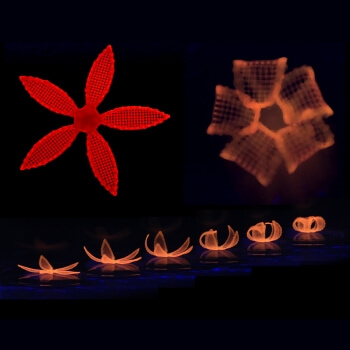News
This series of images shows the transformation of a 4D-printed hydrogel composite structure after its submersion in water. Credit: Wyss Institute at Harvard University
(CAMBRIDGE, Mass.) – A team of scientists at the Harvard John A. Paulson School of Engineering and Applied Sciences (SEAS) and the Wyss Institute for Biologically Inspired Engineering at Harvard University has extended their microscale 3D printing technology to the fourth dimension: time. Inspired by natural structures like plants, which change their form over time according to environmental stimuli, the team has unveiled 4D-printed hydrogel composite structures that change shape upon immersion in water.
“This work represents an elegant advance in programmable materials assembly, made possible by a multidisciplinary approach,” said Jennifer A. Lewis, senior author on the new study. “We have now gone beyond integrating form and function to create transformable architectures.”
Lewis is the Hansjörg Wyss Professor of Biologically Inspired Engineering at SEAS and a Core Faculty member at the Wyss Institute. L. Mahadevan, the Lola England de Valpine Professor of Applied Mathematics, Professor of Organismic and Evolutionary Biology, and Professor of Physics at Harvard, as well as a Wyss Core Faculty member, is a co-author on the study. Their team also includes co-author, Ralph Nuzzo, the G.L. Clark Professor of Chemistry at the University of Illinois at Urbana-Champaign.
In nature, flowers and plants have tissue composition and microstructures that result in dynamic morphologies that change according to their environments. Mimicking the variety of shape changes that plant organs such as tendrils, leaves, and flowers undergo in response to environmental stimuli such as humidity and/or temperature, the 4D-printed hydrogel composites developed by Lewis and her team are programmed to contain precise, localized swelling behaviors. The hydrogel composites contain cellulose fibrils that are derived from wood and are similar to the microstructures that enable shape changes in plants.
Reported today in Nature Materials, the 4D printing advance combines materials science and mathematics. The study’s co-lead authors are A. Sydney Gladman, a graduate research assistant advised by Lewis, specializing in the printing of polymers and composites; and Elisabetta Matsumoto, a postdoctoral fellow advised by Mahadevan, specializing in condensed matter and material physics.
By aligning cellulose fibrils during printing, the hydrogel composite ink is encoded with anisotropic swelling and stiffness, which can be patterned to produce intricate shape changes. The anisotropic nature of the cellulose fibrils gives rise to varied directional properties that can be predicted and controlled. Like wood, which can be split more easily along the grain than across it, the hydrogel-cellulose fibril ink undergoes differential swelling behavior along and orthogonal to the printing path when immersed in water. Combined with a proprietary mathematical model developed by the team that predicts how a 4D object must be printed to achieve prescribed transformable shapes, the method opens up potential applications for 4D printing including smart textiles, soft electronics, biomedical devices, and tissue engineering.
“Using one composite ink printed in a single step, we can achieve shape-changing hydrogel geometries containing more complexity than any other technique, and we can do so simply by modifying the print path,” said Gladman. “What’s more, we can interchange different materials to tune for properties such as conductivity or biocompatibility.”
The composite ink that the team uses flows like liquid through the printhead, yet rapidly solidifies once printed. A variety of hydrogel materials can be used interchangeably resulting in different stimuli-responsive behavior, while the cellulose fibrils can be replaced with other anisotropic fillers of choice, including conductive fillers.
“Our mathematical model prescribes the printing pathways required to achieve the desired shape-transforming response,” said Matsumoto. “We can control the curvature both discretely and continuously using our entirely tunable and programmable method.”
Specifically, the mathematical modeling solves the “inverse problem”, which is the challenge of being able to predict what the printing toolpath must be in order to encode swelling behaviors toward achieving a specific desired target shape.
“It is wonderful to be able to design and realize, in an engineered structure, some of nature’s solutions,” said Mahadevan, who has studied phenomena such as how botanical tendrils coil, how flowers bloom, and how pine cones open and close. “By solving the inverse problem, we are now able to reverse-engineer the problem and determine how to vary local inhomogeneity, i.e. the spacing between the printed ink filaments, and the anisotropy, i.e. the direction of these filaments, to control the spatiotemporal response of these shapeshifting sheets. ”
This work was supported by funding from the Army Research Office (ARO) and the National Science Foundation’s Materials Research Science and Engineering Center (MRSEC).
IMAGES AND VIDEO AVAILABLE
Cutting-edge science delivered direct to your inbox.
Join the Harvard SEAS mailing list.
Press Contact
Paul Karoff
